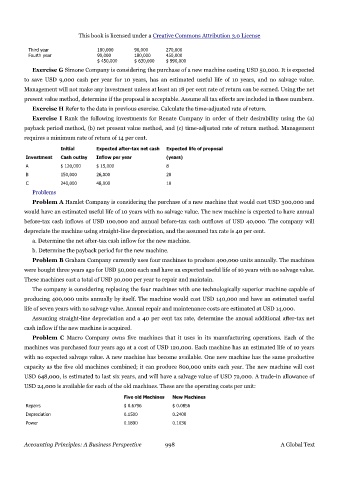Page 997 - Accounting Principles (A Business Perspective)
P. 997
This book is licensed under a Creative Commons Attribution 3.0 License
Third year 180,000 90,000 270,000
Fourth year 90,000 180,000 450,000
$ 450,000 $ 630,000 $ 990,000
Exercise G Simone Company is considering the purchase of a new machine costing USD 50,000. It is expected
to save USD 9,000 cash per year for 10 years, has an estimated useful life of 10 years, and no salvage value.
Management will not make any investment unless at least an 18 per cent rate of return can be earned. Using the net
present value method, determine if the proposal is acceptable. Assume all tax effects are included in these numbers.
Exercise H Refer to the data in previous exercise. Calculate the time-adjusted rate of return.
Exercise I Rank the following investments for Renate Company in order of their desirability using the (a)
payback period method, (b) net present value method, and (c) time-adjusted rate of return method. Management
requires a minimum rate of return of 14 per cent.
Initial Expected after-tax net cash Expected life of proposal
Investment Cash outlay Inflow per year (years)
A $ 120,000 $ 15,000 8
B 150,000 26,000 20
C 240,000 48,000 10
Problems
Problem A Hamlet Company is considering the purchase of a new machine that would cost USD 300,000 and
would have an estimated useful life of 10 years with no salvage value. The new machine is expected to have annual
before-tax cash inflows of USD 100,000 and annual before-tax cash outflows of USD 40,000. The company will
depreciate the machine using straight-line depreciation, and the assumed tax rate is 40 per cent.
a. Determine the net after-tax cash inflow for the new machine.
b. Determine the payback period for the new machine.
Problem B Graham Company currently uses four machines to produce 400,000 units annually. The machines
were bought three years ago for USD 50,000 each and have an expected useful life of 10 years with no salvage value.
These machines cost a total of USD 30,000 per year to repair and maintain.
The company is considering replacing the four machines with one technologically superior machine capable of
producing 400,000 units annually by itself. The machine would cost USD 140,000 and have an estimated useful
life of seven years with no salvage value. Annual repair and maintenance costs are estimated at USD 14,000.
Assuming straight-line depreciation and a 40 per cent tax rate, determine the annual additional after-tax net
cash inflow if the new machine is acquired.
Problem C Macro Company owns five machines that it uses in its manufacturing operations. Each of the
machines was purchased four years ago at a cost of USD 120,000. Each machine has an estimated life of 10 years
with no expected salvage value. A new machine has become available. One new machine has the same productive
capacity as the five old machines combined; it can produce 800,000 units each year. The new machine will cost
USD 648,000, is estimated to last six years, and will have a salvage value of USD 72,000. A trade-in allowance of
USD 24,000 is available for each of the old machines. These are the operating costs per unit:
Five old Machines New Machines
Repairs $ 0.6796 $ 0.0856
Depreciation 0.1500 0.2400
Power 0.1890 0.1036
Accounting Principles: A Business Perspective 998 A Global Text

